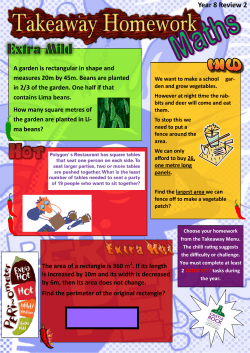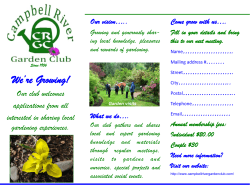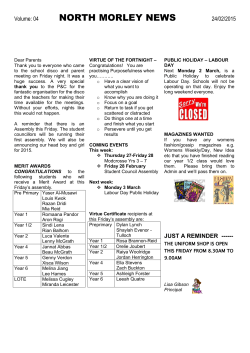
2015 Sunset Article 1 - UCLA Extension Landscape Architecture
Home & Garden ga r d e n t r end local Heroes When garden designer Lauren Springer Ogden moved from Phila- delphia to Colorado, she headed straight for Rocky Mountain National Park, where she lay down in an alpine meadow covered in blue phlox. “Everything was blooming,” she says. “It was like The Sound of Music.” When she moved into her house, in Fort Collins, Colorado, Springer Ogden got to work designing the garden with plants endemic to the region. “I like wild places, and I’m always trying to create something inspired by what I’ve seen in nature.” Springer Ogden is one of a growing number of garden designers embracing native plants. The reasons are as much practical as they 52 April 2015 ❖ SunSet are aesthetic. Natives are natural surviLewisia cotyledon is native to Northvors. In the Northwest, these plants have ern California and evolved to handle not only lots of rain, but Southern Oregon. also dry conditions in summer. In the Rockies, some alpine species of natives thrive at 14,000 feet. And many plants from California and the Southwest have adapted to long periods of drought. “Why mess around with plants that you have to try to keep alive?” says Phoenix landscape architect Steve Martino. “Natives just fit.” The definition of a native plant is up for some debate. More JOHN GRANEN Native plants save you water—and rescue your garden from blandness. By Johanna Silver Home & Garden persnickety types define “native” as any plant that’s endemic to a 5-mile radius of your home. (“That’s like marrying your cousin,” says Springer Ogden.) But most experts consider a native to be any plant that grew in America before mass European expansion, and they say that choosing a plant based on the type of region it evolved in (coastal bluffs, alpine ranges) is more important than state boundaries. In any case, these plants are long overdue for a public-image rehab. When Martino started designing gardens in the 1970s, he had to work hard to convince clients to plant natives. “Homeowners just wanted whatever they grew up with,” he says. “They thought desert plants looked too dry.” Today, the lack of plant diversity at big-box stores means that many yards can still look as homogeneous as the pit stops along highways. “I find myself driving through neighborhoods in Southern California, thinking: I could be anywhere,” says David Fross, founder of Native Sons Nursery in Arroyo Grande, California. But with recurring droughts, the tide is finally changing. Native-plant nurseries report that sales are up, and native-plant societies are seeing their memberships grow. “There’s a whole philosophical shift,” Fross says. “We need to start moving away from overly irrigated, always-green landscapes.” Natives can take some getting used to, particularly in drier regions, where they go dormant during the summer months. But there is beauty in dormancy, says Fross. “I love to watch the Eriogonum seeds deepen into their rust color against gray foliage and grasses.” Something else almost miraculous happens once you plant a native garden. Birds, bees, and other insects—often natives Fort collins, CO themselves—show up. “Native plants can be a window to this parallel universe of pollinators,” says Martino. “I planted a Typically, when people want a Conoclinium greggii ‘Boothill’, and I swear wide-open space in their yard, that masses of queen butterflies—a native they plant a lawn. But garden designer Lauren Springer I’ve never seen in 30 years of living here— Ogden had a different idea in appeared out of nowhere.” Experts conmind: “I wanted something that firm that these kinds of gardens make a didn’t require a lot of water or fertilizer,” she says. “I didn’t significant difference. “In an era when want it to look domestic.” This we’re doing so much development, native meadow changes beautifully gardens provide corridors for plants and with the seasons. When reflecting the moonlight in winter, it animals to survive,” says Bart O’Brien, bolooks like snow. In the spring, tanic garden manager for The Regional the fescue and junegrass turn Parks Botanic Garden in Berkeley. bluish green. By early summer, the warm-season grasses grow, And although native gardens may have a and it’s gray-green. “It’s never reputation for being wild and unkempt, emerald green like a lawn,” there’s more room for design than gardensays Springer Ogden. “It’s more like a prairie.” ers might think. “Not every native garden has to replicate a natural habitat,” says JaThe plants : The meadow includes blue grama grass (Boutelson Dewees, horticulturist at Flora Grubb oua gracilis), native fescues, Gardens in San Francisco. “The bees don’t and junegrass. Nearby is a ruby care if the plants are manicured or if they’re muhly (Muhlenbergia reverchonii) covered in pink flowers. planted as a billowy mass—they’re still Enclosing the space are trees going to come.” such as dwarf Colorado spruce Whether wild or manicured, a native (Picea pungens ‘Mesa Verde’), native hybrid Rocky Mountain garden creates a sense of place—as the birch (Betula x hybrida ‘Rocky examples on these pages show. As Springer Mountain Splendor’), and a Ogden puts it: “This is my piece of serenity Wasatch maple (Acer grandidentatum) in full fall color. in suburbia.” Plains sanctuary 54 A p r i l 2 0 1 5 ❖ S u n s e t D. A. Horchner “Every yard across the country shouldn’t look the same. Native plants define what’s unique about where you are.” — D av i d S a l m a n , F o u n d e r , H i g h C o u n t r y G a r d e n s Home & Garden los angeles “When I got into landscape architecture, I decided that I was going to use my garden as a laboratory,” says Tom Rau. Over the past three years, he’s turned a typical urban front yard filled with shade and clay soil into a lush native garden reminiscent of a scene along a hiking trail. “The drought’s been building for many years,” he says. “This kind of landscaping helps us adapt.” The plants : Rau planted grassy Carex texensis between pavers, and clumps of C. divulsa and C. pansa on either side. The strappy leaves of a native iris grow at left, while a giant chain fern (Woodwardia fimbriata) stands tall at right. Pink flowers of Heuchera ‘Wendy’ appear in the foreground. 56 a p r i l 2 0 1 5 ❖ S u n s e t Paradise Valley, AZ Desert drama “With just a few distinctive desert plants, you can evoke a sense of place,” says Steve Martino, the landscape architect behind this Arizona backyard. To show off the plants’ architectural shapes, he painted one wall red. He chose plants for brightness too. When the native mesquite tree’s yellow flowers bloom in the spring, “the color knocks your eyes out,” he says. The plants : Three Agave americana hold their form year-round next to the Arizona mesquite (Prosopis velutina). Below it, brittlebush (Encelia farinosa) leads the eye down the path with yellow blooms atop silvery foliage. clockwise from top left: Thomas J. Story, John Granen, Steven A. Gunther Coastal retreat ShorEline, Wa Suburban woodland When Ellen Hauptmann and Dave Flotree started gardening at their home just outside Seattle 14 years ago, the total wildlife population consisted of two crows. Now, thanks to the native garden they planted on most of their one-third acre, they see chickadees, towhees, thrushes, finches, flickers, and even sharpshinned hawks and great blue herons. “We really designed this garden for the birds,” says Hauptmann. Twice a year, the couple head to the plant sale of the Washington Native Plant Society, bringing home plants typically found in redwood forests to refresh their yard. The plants : The groundcover is redwood sorrel (Oxalis oregana). Planted at center are vine maples (Acer circinatum) and Western sword ferns (Polystichum munitum). DIGITAL BONUS Find 23 knockout native plants from around the West: sunset.com/ natives. S u n s e t ❖ A p r i l 2 0 1 5 57
© Copyright 2025











